 |
Picks is a monthly sampling of Japan's art scene, offering commentary by a variety of reviewers about current or recent exhibitions at museums and galleries around the country.
Note: As of 1 October, Japan is no longer under a state of emergency. Most museums and galleries are open, but some may still require reservations or have other anti-Covid measures in place. If you are planning a visit, please check the venue's website beforehand. |
 |
 |
|
|
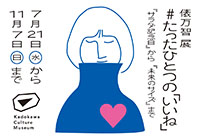 |
 |
 |
 |
| Machi Tawara: #One and Only "Like" and Size of the Future from Salad Anniversary |
| 21 July - 5 December 2021 |
Kadokawa Culture Museum
(Saitama) |
 |
|
An in-depth look at the life and work of Tawara, a contemporary poet best known for her celebrated debut, a book of short tanka verse titled Salad Anniversary. The exhibition is loosely divided into three areas that trace the poet's development through the stages of childhood, young adulthood, and motherhood, up to her recent collection Size of the Future. Imaginatively designed by Torafu Architects, the displays reflect the content of Tawara's work: the section on Salad Anniversary, which is full of love poems, features large heart-shaped stands inscribed with the verses in three dimensions. The staging complements the vitality of her texts with a sturdy physicality -- a brilliant solution to the problem of how to set up an exhibition on the intangible medium of words.
|
|
|
 |
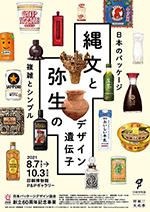 |
 |
 |
 |
| Complexity and Simplicity: Jomon and Yayoi DNA in Japanese Package Design |
| 7 August - 3 October 2021 |
Printing Museum, Tokyo
(Tokyo) |
 |
| If we go back far enough, Japanese design could be said to have its origins in the prehistoric Jomon and Yayoi eras. Jomon earthenware brims with life and makes full and intricate use of its three dimensions. Yayoi pottery, though produced later, is by contrast simple, flat-surfaced and functional. Daring to classify works of contemporary package design as either "Jomon" or "Yayoi" in style, this show further divides them according to the themes of Beauty, Cuteness, Functionality, Allure, and Character, offering visitors an opportunity to explore the genetics of Japanese design as well as their own tastes. Are you a Jomon type or a Yayoi type? |
|
|

|
 |
 |
|
 |
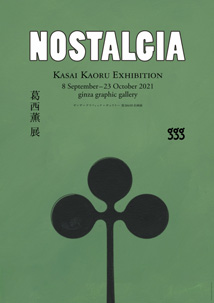 |
 |
 |
 |
| Kasai Kaoru Exhibition: Nostalgia |
| 8 September - 23 October 2021 |
Ginza Graphic Gallery
(Tokyo) |
 |
|
Graphic designer Kasai declares that "nostalgia" means "a fascination with things that have no meaning or that you don't understand -- and with what lies deep inside them." He further avers that he experiences nostalgia through manual work: whether using a ruler, preparing sumi ink, squeezing a paint tube, or sharpening a pencil, all produce evocative sensations, sounds and smells that awaken ancient, primitive feelings from where they lay dormant in his body. Rich with humor, pathos, intelligence, and innocence -- qualities that seem to be on the wane in contemporary society -- these works offer clues on how to cope with the stresses of life today, whether from the coronavirus pandemic or the unforgiving rigidity of all things digital.
|
|
|
|
|
|
|
|

|
 |
 |
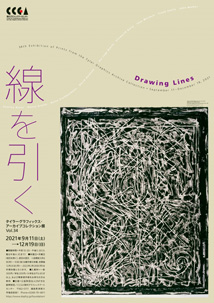 |
 |
 |
 |
| Drawing Lines: 34th Exhibition of Prints from the Tyler Graphics Archive Collection |
| 11 September - 19 December 2021 |
Center for Contemporary Graphic Art
(Fukushima) |
 |
|
According to the curators: "Once they were liberated from the need to serve as a component element of a form, lines became free to play a leading role in an artwork in their own right. It also became possible to express a print image by physical rhythm: the act of drawing lines by moving a burin or needle across a copper plate, or by applying crayon on a lithographic stone. In these ways, artistic expression that derives chiefly from lines has given birth to many attractive works of great diversity and new meanings. This exhibition will offer visitors a look at prints featuring impressive expressions of lines gleaned from CCGA's Tyler Graphics Archive Collection, including works by Frank Stella and Nancy Graves."
|
|
|
 |
 |
 |
 |
| Taro Photos Mandala: Takashi Homma Selects Works by Taro Okamoto |
| 17 July - 11 October 2021 |
Taro Okamoto Museum of Art, Kawasaki
(Kanagawa) |
 |
|
The "works" selected by photographer Homma are not images of objects recorded by Okamoto in the course of his field studies. Rather, they appear to be random shots of roadside signs, buildings, women he encountered in his travels, and the like -- i.e., people and things he just happened to see and snap. They are the artist's "works" only in the sense that he was there to press the shutter when some event or other took place. Yet taken as a whole, these offhand snapshots form a microcosm of the "Taro universe," offering a new perspective on his relationship with photography.
|
|

|
 |
 |
 |
|
|
 |
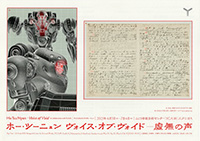 |
 |
| Ho Tzu Nyen: Voice of Void |
| 3 April - 4 July 2021 |
Yamaguchi Center for Arts and Media
(Yamaguchi) |
 |
| This multimedia work by the Singapore-born artist focuses on the Kyoto School, an informal network of philosophers that exercised considerable intellectual influence in the Japan of the war years, the 1930s and 1940s. After introducing the Kyoto School, Ho uses the installation space to physically lay out the development of its core members' various lines of thought. After watching an anime-style video, visitors enter a virtual-reality space where they find themselves by turns in a tea house, a jail, the sky, and a Zen meditation room while listening to real-voice readings. Ho offers an implicit critique of such media as anime and VR even as he employs them to give physical form to the complex dynamics of the system that drove Japan's military adventures.
|
|
|
|
|
|
|
 |
 |
| Rethinking Western Art in Yamagata |
| 17 July - 27 August 2021 |
Yamagata Museum of Art
(Yamagata) |
 |
|
For this exhibition, the National Museum of Western Art, Tokyo has loaned some of the most valuable works in its collection to the Yamagata Museum of Art -- but this is not just a showcase of big-name artists. The theme is the reception of Western art in Japan, and the dynamic presentation skillfully brings together works from both museums, including those by Western-influenced artists in Yamagata, to tell that story. With the loaning of artworks between museums in Japan and abroad nearly brought to a halt by the pandemic, we are presented with an opportunity to find ways to more effectively utilize domestic collections, as well as to reconsider the reality of the great distances over which art must travel between this country and the West.
|
|
 |
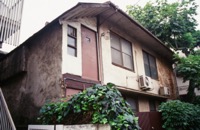 |
 |
| Yuta Akiyama: Supervision |
| 1 August - 5 September 2021 |
White House
(Tokyo) |
 |
|
This show took place in the legendary, recently renovated Shinjuku White House, architect Arata Isozaki's maiden work and an artists' mecca of the late fifties and sixties. Akiyama's installation of architectural materials veered wildly between the physical and the digital, as well as venturing outside into the streets of Kabukicho, where works situated in parks and other venues did a dance between art and architecture. Each installation was a tiny gesture, but collectively they mustered a forceful architectural critique of the national mega-project recently foisted on the populace in the name of the Olympics. In this sense Akiyama's work carries on the spirit of the old White House of the sixties.
|
|
|
|
|
 |
|